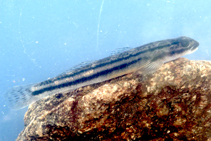| Diagnosis: |
Dorsal spines (total): 7-7; Dorsal soft rays (total): 9-9; Anal spines: 1-1; Anal soft rays: 10-10. Diagnosis: A Sicyopus species which is distinguished from all the other species with the following set of characters: (i) a particular colour pattern, being similar in both sexes with three blackish bands present on the flanks: the first band extends from the tip of snout and upper lip, under the eye to the posterior edge of operculum and pectoral base, and from pectoral base to hypural; the second extends from behind the eye to the caudal fin; and the third runs along the upper part of flank from above the pectoral fin to the second dorsal fin base; (ii) a second dorsal fin with nine soft rays; (iii) a shorter caudal fin length in male; (iv) more scales in lateral series, 35–43, and transverse back scale series, 12–18 (Ref. 87905).
Description: Dorsal fins VI-I,9; spines slightly filamentous in males and less so in females, spines 3 and 4 longer; first dorsal fin not contacting second dorsal fin basally, when depressed; anal fin I,10; pectoral fin rays 15; caudal fin with 13 branched rays with posterior margin slightly rounded; pelvic disc with one spine and five strongly branched rays (Ref. 87905). Scales in lateral series 35-43; scales may extend midlaterally over the origin of first dorsal fin in male and second dorsal fin in female, and posteriorly to hypural base; scales usually ctenoid from hypural base to origin of the second dorsal fin and cycloid elsewhere; scales along dorsum usually extending anteriorly along medial base of second dorsal fin, may extend to base of first dorsal fin; scales in zigzag series 6-10, transverse back series 12-18, transverse forward series 11-16; predorsal midline naked; head, breast and pectoral base usually naked; belly usually naked or with few cycloid scales (Ref. 87905). Upper jaw teeth mostly conical in the female with more and shorter teeth, 10-15, than male, 7-9, mostly caniniform; lower jaw teeth conical in female, 7-9, and males, 4-6 (Ref. 87905). Cephalic sensory pore system A, B, C, D, F, H, K, L, N and O; D singular, with all others paired; oculoscapular canal separated into anterior and posterior canals between pores H and K (Ref. 87905).
Colouration: Colour in preservation: the sexual dichromatism is not well developed; background of head and body greyish; body greyish dorsal to midline; head greyish dorsally with small blackish dots; a blackish band extending from the tip of snout and upper lip, under the eye to the posterior edge of operculum and pectoral base, and from pectoral base to hypural; head whitish under this band and ventrally; blackish horizontal band above the pectoral fin to the second dorsal fin base; snout blackish; nape greyish; faint and thin blackish band extending from pectoral base to caudal fin along body midline; first and second dorsal fin hyaline, with several blackish dots; dorsal fin spines highlighted by black pigments; caudal fin dusky to greyish, with three to four vertical blackish bands; anal fin dusky to hyaline with black pigments; pelvic disc entirely white; pectoral fin dusky becoming whitish dorsally and ventrally; pectoral base blackish medially, slightly dusky ventrally and dorsally (Ref. 87905). Colour in life: the sexual dichromatism is not well developed; body dusky to slightly yellowish; three horizontal blackish bands on the flanks; the first one from the tip of snout and upper lip, under the eye, to the posterior edge of operculum and pectoral base, and from pectoral base to hypural; colour above this band iridescent gold in the last third of the body; second black band from the back of the eye to the caudal fin; third one along the upper part of flank from above the pectoral fin to the second dorsal fin base; dorsal and anal fins dusky to hyaline with black pigments on the rays; caudal fin greyish with three to four vertical blackish bands; pectoral fins hyaline; belly of male fish whitish to greyish; belly bright orange in gravid female fish (Ref. 87905). |

